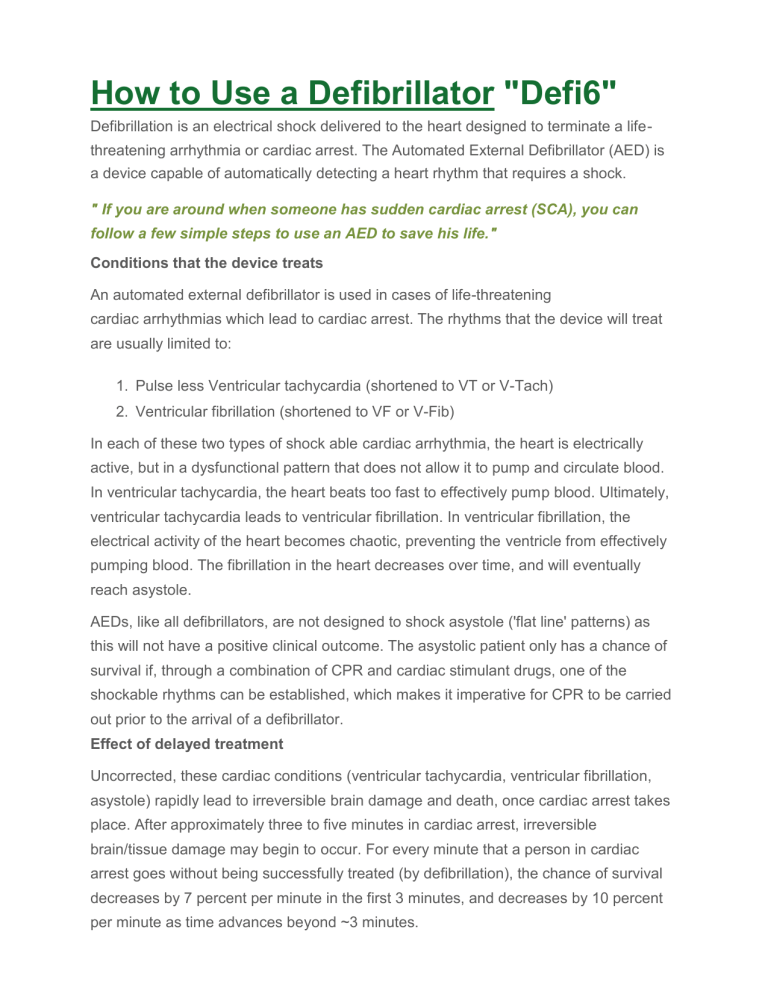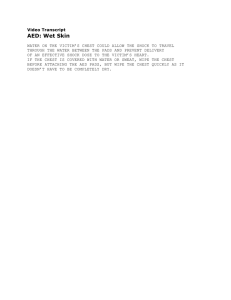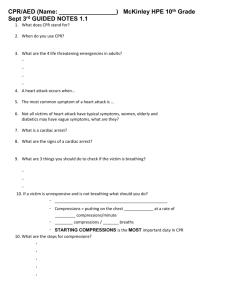how to use AED
advertisement

How to Use a Defibrillator "Defi6"
Defibrillation is an electrical shock delivered to the heart designed to terminate a lifethreatening arrhythmia or cardiac arrest. The Automated External Defibrillator (AED) is
a device capable of automatically detecting a heart rhythm that requires a shock.
" If you are around when someone has sudden cardiac arrest (SCA), you can
follow a few simple steps to use an AED to save his life."
Conditions that the device treats
An automated external defibrillator is used in cases of life-threatening
cardiac arrhythmias which lead to cardiac arrest. The rhythms that the device will treat
are usually limited to:
1. Pulse less Ventricular tachycardia (shortened to VT or V-Tach)
2. Ventricular fibrillation (shortened to VF or V-Fib)
In each of these two types of shock able cardiac arrhythmia, the heart is electrically
active, but in a dysfunctional pattern that does not allow it to pump and circulate blood.
In ventricular tachycardia, the heart beats too fast to effectively pump blood. Ultimately,
ventricular tachycardia leads to ventricular fibrillation. In ventricular fibrillation, the
electrical activity of the heart becomes chaotic, preventing the ventricle from effectively
pumping blood. The fibrillation in the heart decreases over time, and will eventually
reach asystole.
AEDs, like all defibrillators, are not designed to shock asystole ('flat line' patterns) as
this will not have a positive clinical outcome. The asystolic patient only has a chance of
survival if, through a combination of CPR and cardiac stimulant drugs, one of the
shockable rhythms can be established, which makes it imperative for CPR to be carried
out prior to the arrival of a defibrillator.
Effect of delayed treatment
Uncorrected, these cardiac conditions (ventricular tachycardia, ventricular fibrillation,
asystole) rapidly lead to irreversible brain damage and death, once cardiac arrest takes
place. After approximately three to five minutes in cardiac arrest, irreversible
brain/tissue damage may begin to occur. For every minute that a person in cardiac
arrest goes without being successfully treated (by defibrillation), the chance of survival
decreases by 7 percent per minute in the first 3 minutes, and decreases by 10 percent
per minute as time advances beyond ~3 minutes.
Part1
Preparing to Use the AED
1
Confirm cardiac arrest. If you see a person who appears to have an emergency
episode, you need to check to ensure that it is cardiac arrest before you use an AED.
Check to see if the victim is unable to respond, if he is breathing, and his pulse. You can
use the ABC method. If you find no pulse or breath, you need to start CPR.
Airway: You need to make sure the airway is open before you check his breathing. To
do this, tilt back his head and lift up his chin. If you see an object obstructing the airway,
remove it.
Breathing: Lean in closely to listen for breathing. Look to see if his chest is rising and
falling.
Circulation: Feel for a pulse. Signs of circulatory issues include color changes,
sweating, and a lower level of consciousness.
2
Try to wake the person up. If you come upon a person and you have no idea how long
he has been unconscious, you need to make sure he is actually having medical
problems and is not just asleep. To try to wake him up, you can shake him, yell into his
ear, or try clapping near him. If he shows no signs of waking up, confirm cardiac arrest.
Never shake a child or infant. This can lead to serious injury.
3
Call 911. As soon as you assess that it is an emergency situation, you need to call 911.
Explain to them where you are and what is going on. Let them know that you have an
AED on site and that you plan to use it.
If there is someone else there other than you, make them call 911 while you start
working on the person in need. They can also run and grab the AED from its location.
This way things will get done faster, which is important with SCA.
4
Start CPR. If you are not there alone, you should start giving CPR while the other
person is getting the AED. If you are alone, call 911, then start CPR.
Give 30 chest compressions and then 2 rescue breaths for every 30 chest
compressions. The rescue breaths should be no longer than one second. Avoid
overventilation and only provide enough air to see the chest expand.
Keep chest compressions to 100 compressions per minute. Do not exceed 125
compressions per minute. You should compress the chest 2 inches (5 cm) downwards
and allow it to fully expand upwards with as few interruptions as possible.
You should give CPR right away if you don't know how long a person has been
unconscious, then you should use the AED.
Part2
Using the AED
1
Make sure the patient is dry. Before you turn on and use an AED, you need to make
sure that the person you are helping is not wet. If they are, you need to dry them off. If
there is water in the immediate area, you need to move the person to a dry place.
Water conducts electricity. If the patient is wet or if there is water nearby, he can be
seriously injured.
Num.
Feature
1
Self test LCD indicator
2
Function key
3
MIC
4
Shock button
5
Shock LED indicator
6
Speaker
7
Power LED indicator
8
On/Off button
9
Patient cable connector
2
Turn on the AED. Once you are sure there is no water, you need to turn on the AED.
When it comes on, it will give you instructions of how to handle the situation. It will likely
tell you to attach the cables for the pads into the AED machine. You typically hook them
up above the blinking light on the top of the machine.
It will also instruct you to prepare the person once the pads are plugged in.
3
Prepare the chest area. To use the AED pads, you must remove certain things from
the victim. Open or cut through his shirt. If his chest is very hairy, you will have to shave
it. You should also look for signs of implanted devices, such as a pacemaker. If you see
any metal jewelry or accessory, remove it. The metal will conduct electricity.
Most AEDs come with a razor to shave or scissor to trim the chest of a hairy person.
You will be able to see a pacemaker or other implanted device through the chest. You
can also look for a medical alert bracelet.
If the victim is a woman, you need to take off any bra that has under wire in it. It can
conduct electricity just like jewelry.
4
Apply the pads. The electrodes for the AED are typically adhesive pads. The AED will
advise you to put the electrodes or pads in place. You need to make sure that they are
placed correctly so the victim will get the maximum amount of shock necessary. One
pad should be placed below the collarbone on the upper right side of the victim's bare
chest. The other should be placed below the peck or breast on the left, at the bottom of
his heart, slightly along his side.
Make sure there is no fabric or other object between the pads and his skin. Any
obstruction will make the AED malfunction.
If the pads are not put on properly, the AED may repeat "check electrodes."
If you found an implanted device or piercing, the pads should be at least 1 inch from
them.
5
Let the AED analyze. Once the pads are properly in place, you need to get everyone
clear of the victim. When everyone has moved back, press the analyze button on the
AED. It will begin to analyze the heart rhythm of the victim.
The AED will then tell you if a shock is needed or if you need to keep doing CPR. If no
shock is needed, this means that the victim has regained a pulse or has an unshakable
heart rhythm.
If there is no shock advised, you need to continue CPR until emergency workers arrive.
6
Shock the victim if necessary. If the AED advises that you need to shock the patient,
you need to make sure, once again, that the victim is clear. Once you do, push
the shock button on the AED. This will send an electric shock through the electrodes to
help restart the heart.
The AED will only give one shock at a time. It doesn't last that long, but expect him to
move with the force of the shock.
7
Continue CPR. Once you have given the victim a shock, you need to continue CPR.
You should do it for 2 additional minutes and then let the AED check for a heart rhythm
again. Keep this up until emergency services arrive.
You should also stop if the victim can breathe on his own or if he regains
consciousness.
The AED will likely remind you when 2 minutes has passed and tell you to stop CPR.
References
Wekipidia ,Wekihow ,Meditech Group http://www.meditech.com.cn


